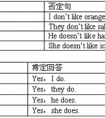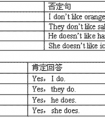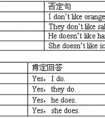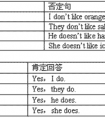改错。( )1. ―What is Lily?―She's my sister. A B C D( )2. ―Is that a ball pen?―No, that isn't. A BC D( )3. It's time to go to home.A B C D( )4. This i-三年级英语
mine
yours
his
her
its
ours
yours
theirs
汉语意思
我的
你的
他的
她的
它的
我们的
你们的
他(她它)们的
This is her dress. / This dress is hers.
物主代词的用法:
物主代词既有表示所属的作用又有指代作用,例如:
John had cut his finger; apparently there was a broken glass on his desk.
约翰割破了手指,显而易见,他桌子上有个破碎的玻璃杯。
物主代词有形容词性(my, your等)和名词性(mine, yours等)两种,形容词性的物主代词属于限定词。
名词性的物主代词在用法上相当于省略了中心名词的 --'s属格结构,例如:
Jack's cap 意为 The cap is Jack's.
His cap 意为 The cap is his.
名词性物主代词的句法功能:
a. 作主语,例如:
May I use your pen? Yours works better.
我可以用一用你的钢笔吗? 你的比我的好用。
b.作宾语,例如:
I love my motherland as much as you love yours.
我爱我的祖国就像你爱你的祖国一样深。
c.作介词宾语,例如:
You should interpret what I said in my sense of the word, not in yours.
你应当按我所用的词义去解释我说的话,而不能按你自己的意义去解释。
d.作主语补语,例如:
The life I have is yours. It's yours. It's yours. 我的生命属于你,属于你,属于你。
物主代词的意思是物品主人的代词。
| 人称代词 | 第一人称单数 | 第二人称单数 | 第三人称单数 | 第一人称复数 | 第二人称复数 | 第三人称复数 |
| 主格 | I | you | he/she/it | we | you | they |
| 宾格 | me | you | him/her/it | us | you | them |
| 汉语 | 我 | 你 | 他 | 我们 | 你们 |
他/她/它们 |
| 形容词性物主代词 | my | your | his/her/its | our | your | their |
| 名词性物主代词 | mine | yours | his/hers/its | ous | yours | theirs |
| 汉语 | 我的 | 你的 | 他的/她的/它的 | 我们的 | 你们的 | 他/她/它们的 |
考点名称:地点副词
- 地点副词:
表示地点的副词和表示位置关系的副词统称为地点副词。常见的地点副词有:
表示地点的:
here, there, home, upstairs, downstairs, anywhere, everywhere, nowhere, somewhere, abroad, elsewhere等。
表示位置关系的:
above, below, down, up, out, in, across, back, along, over, round, around, away, near, off, on, inside, outside, past等。
在表示位置关系的副词中,有些副词也可用作介词(如:above, over, beyond, around, below, down, up, in, along, near, off, on, past等),在没有宾语时就是副词,有宾语时就是介词,如:
Come in, please. (副词)
They live in the next room. (介词)
Let's take along. (副词)
Let's walk along this street. (介词) - 地点副词在句子中的位置及用法举例:
地点副词一般位于句尾,有时可位于句首,但通常不位于句中。若有多个副词排列,地点副词通常位于方式副词之后,时间副词之前。例如:
Here comes the school. 校车来了。
Let's go home. 让我们回家吧。(注意:地点副词前不用介词)
考点名称:系动词
- 系动词:
亦称连系动词,作为系动词,它本身有词义,但不能单独用作谓语,后边必须跟表语,亦称补语(形容词),构成系表结构说明主语的状况、性质、特征等情况。
be(是)是最基本的系动词。小学涉及到的系动词需要掌握的am, is, are
如:I am from Beijing. 我来自北京。
My mother is a teacher. 我的妈妈是一位老师。
除了系动词be,常用的系动词还有look(看起来)、sound(听起来)、feel(感觉到)、become(变成)、smell(闻起来)等。
例:The boy looks very happy. 这个男孩看起来很高兴。
The dish smells good. 这盘菜闻起来很香。 be动词意思和用法:
一般的意思是:
是,此种用法,有多种变化形式,is,am,are,was,were,being,been,to be.
另外,be动词还有成为的意思。
根据句子中不同的人称、数和时态,应该选择相应的be动词。<?xml:namespace prefix = "o" ns = "urn:schemas-microsoft-com:office:office" />要看句语的时态:
如果是一般过去时,就用was/were
如果是一般现在时,就用am/is/are
如果是一般将来时,就用will be
然后看主语的人称及复数形式:
一般过去时:
第一人称和第三人称的单数形式,则用was
第一人称和第二人称、第三人称的复数,则用were
一般现在时:
第一人称单数形式,用am
第三人称单数形式,用is
第一人称复数、第二人称、第三人称的复数形式,则用are
一般将来时:
will be
一般时态有关be动词的口诀:
- 最新内容
- 相关内容
- 网友推荐
- 图文推荐
| [家长教育] 孩子为什么会和父母感情疏离? (2019-07-14) |
| [教师分享] 给远方姐姐的一封信 (2018-11-07) |
| [教师分享] 伸缩门 (2018-11-07) |
| [教师分享] 回家乡 (2018-11-07) |
| [教师分享] 是风味也是人间 (2018-11-07) |
| [教师分享] 一句格言的启示 (2018-11-07) |
| [教师分享] 无规矩不成方圆 (2018-11-07) |
| [教师分享] 第十届全国教育名家论坛有感(二) (2018-11-07) |
| [教师分享] 贪玩的小狗 (2018-11-07) |
| [教师分享] 未命名文章 (2018-11-07) |


![____________doyoulike?[ ]A.WhatB.HowC.What's-三年级英语](http://www.00-edu.com/d/file/ks/4/1/26/2019-08-17/smalld0069ba33c4a9e98616d410691314d1e1565980468.png)



